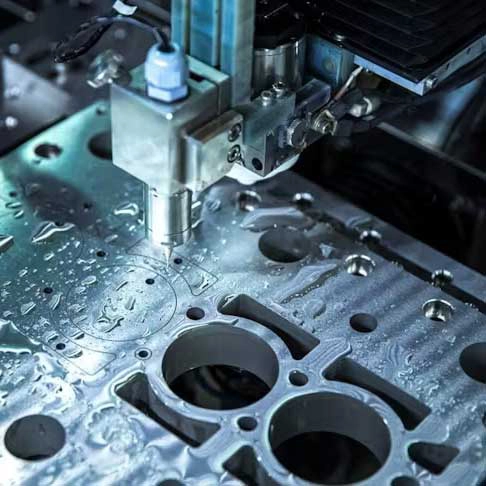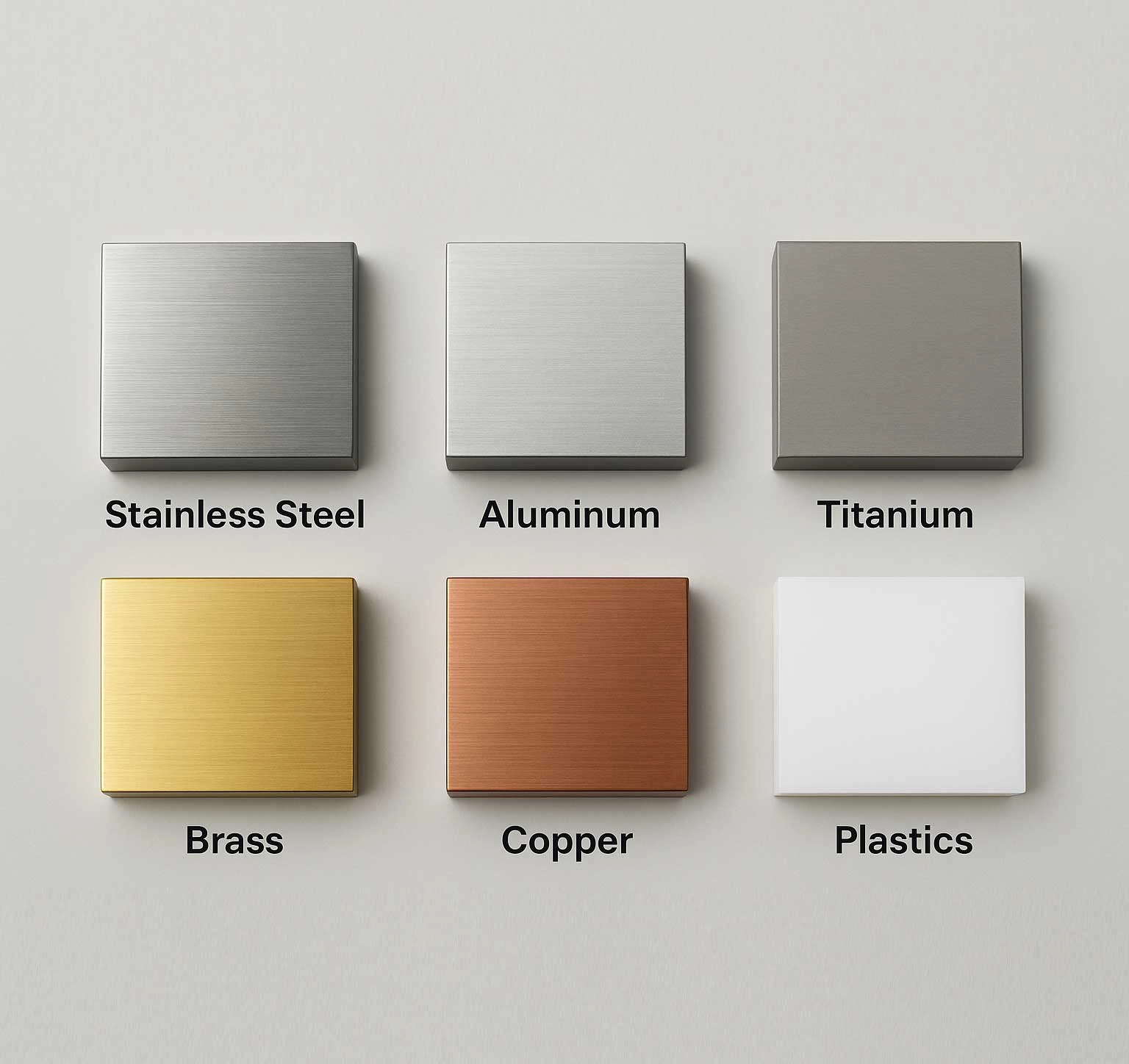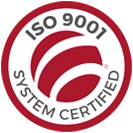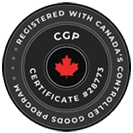CNC Machining Materials
At StenTech, material selection is as critical as machining precision. The right choice impacts strength, durability, corrosion resistance, weight, and performance in real-world conditions. Our machining expertise spans a wide range of metals and engineered plastics, each chosen and processed to meet the exact needs of our customers.
In our facilities, multiple jobs often run simultaneously, across different materials and specifications. This requires expert coordination, deep knowledge of material properties, and advanced manufacturing strategies to ensure every part meets its performance requirements.
Key Considerations Before Material Selection
Before production begins, we assess the part’s purpose, required strength, wear resistance,
environmental exposure, operating temperatures, tolerance requirements, machinability, and
overall cost implications. This ensures we select the most suitable material and machining
method for performance, longevity, and efficiency.
Finishing Options
Post-machining finishes can improve durability, function, and aesthetics. Depending on the
application, we may recommend processes such as anodizing, passivation, powder coating, or
tumble deburring to enhance performance and extend part life.
Common CNC Machining Materials
Stainless Steel – Available in numerous alloys, including 303, 304, 17-7,
and 15-5, stainless steel offers exceptional strength, durability, and corrosion resistance.
Ideal for industries from aerospace to medical, it often undergoes finishing processes such
as passivation or polishing for enhanced performance.
Can you machine stainless steel?
Yes, machining stainless steel is absolutely possible, and in fact, it’s one of the most common materials used in precision parts manufacturing, right alongside aluminum. Machined stainless steel parts play a vital role in business growth for precision manufacturers like StenTech, thanks to the material’s strength, durability, corrosion resistance, and high-quality surface finish.
Popular stainless grades for machining include 303/304, 17-7, 15-5, and 316. Each offers unique properties, from polishability to corrosion resistance, making stainless steel a go-to alloy for industries ranging from aerospace and medical devices to food production, marine, and automotive.
Producing stainless steel begins by combining iron ore with elements such as nickel, chromium, silicon, and molybdenum. For example, 316 stainless steel, an austenitic alloy of chromium, nickel, molybdenum, and iron, is highly valued in marine, chemical, and medical applications.
At StenTech, stainless steel parts are produced using a variety of CNC machining processes:
- CNC Drilling - Creating holes, slots, and programmed depths.
- CNC Lathing - Rotating the material while tool inserts shape cylinders and concentric features.
- CNC Milling - 3-, 4-, and 5-axis machines capable of machining complex geometries.
- CNC Routers - Cutting and drilling stainless sheets.
- CNC Laser Cutting - Excellent for thinner-gauge stainless like 316 or 303/304.
- CNC Plasma Cutting - Effective for industrial applications.
- CNC Waterjet Cutting - Using high-pressure water with abrasives to cut stainless without heat effects.
With modern CNC systems, stainless steel components can be produced with tolerances as tight as ±0.001” (±0.025 mm), repeatable across both small runs and volume production.
What is the most commonly machined stainless steel?
The workhorse of stainless machining is grade 304, also known as 18/8 stainless for its 18% chromium and 8% nickel composition. It’s the most widely used for several reasons:
- Versatility: Excellent formability and strength, adaptable to complex or simple parts.
- Corrosion Resistance: Strong defense against moisture and chemicals.
- Affordability: Widely available at competitive cost, making it a balanced choice for performance and budget.
Other popular options include:
- Grade 303: Optimized for machinability with sulfur additions, though slightly lower in corrosion resistance than 304.
- Grade 316: The ultimate in corrosion resistance, thanks to molybdenum, making it ideal for marine and chemical environments.
Choosing the right stainless grade depends on part complexity, corrosion exposure, budget, and finishing needs.
Can you CNC mill stainless steel?
Absolutely. CNC milling is one of the most effective and widely used processes for machining stainless steel parts, from dental tools to turbine blades and kitchen utensils. Using hardened steel alloy or carbide cutters, CNC mills shape raw stainless stock into precision components guided by CAD/CAM programming.
The key lies in mastering “speeds and feeds”, the spindle rotation speed and material feed rate, to balance tool performance with the specific stainless grade. With grades such as 304, 303, and 316, StenTech’s advanced CNC milling technology ensures precision, efficiency, and repeatability across industries.
The term “stainless machinability” is correct when referring to CNC mills. Stainless machinability allows projects requiring demanding grades such as 316 or 420 stainless steel to achieve high precision and repeatability. The wide availability of stainless alloys across industries demonstrates the trust placed in this versatile material.
With more than six decades of proven credibility, CNC milling of stainless steel and hardened alloys has established itself as a cornerstone of modern manufacturing, and will continue to be for decades to come.
Which Cutting Process is Best for Stainless Steel?
Having the right tool for the job makes all the difference, and machining stainless steel is no exception. Created in 1913 by adding chromium to iron, stainless steel has revolutionized manufacturing for over a century, thanks to its corrosion resistance and strength. Today, a wide range of cutting technologies are available to support industries as diverse as aerospace, medical, food processing, oil and gas, energy, and automotive.
Here’s an overview of the most effective cutting processes for stainless steel:
- Sawing – Traditional sawing with metal or band saw blades is still in use, mostly for rough cuts or bulk shapes without tight tolerance requirements. This method is more common in small shops than in precision machining facilities.
- Wire EDM (Electrical Discharge Machining) – Ideal for producing multiple parts with identical patterns or features while maintaining tight tolerances. Widely used in medical, aerospace, and micro-electronics industries.
- CNC Machining – The backbone of precision stainless manufacturing. Using hardened steel or carbide tools, CNC machining handles grades such as 303, 304, 17-7, 410, and 420. With 4- and 5-axis capabilities, CNC is well-suited for complex, high-precision stainless steel parts.
- Waterjet Cutting – Uses highly pressurized water mixed with abrasives to cut stainless steel with no heat-affected zones. Excellent for sensitive projects and materials like 304 and 316, with tolerances of ±0.005”.
- Plasma Cutting – Effective for cutting thick stainless gauges. By using pressurized gases such as oxygen, argon, or nitrogen, plasma cutting is faster than other methods and keeps costs lower, though edge quality may vary depending on the gas used.
- Laser Cutting – A preferred solution for thinner stainless foils (from 0.0254 mm up to 4 mm) with tolerances as tight as ±0.001”. Using UV, IR, or fiber laser technology, laser cutting delivers precision in grades like 302, 304, 17-7, and 316. This process is especially valuable for R&D and mid-level production across industries such as medical, defense, battery energy, and nuclear science.
Choosing the Right Process
The best process depends on the project’s requirements:
- For 4- or 5-axis precision components: CNC milling is the method of choice.
- For ultra-thin foils and sheet stock: Laser cutting provides unmatched accuracy.
- For applications requiring no heat effects: Waterjet cutting is optimal.
At StenTech, we leverage a broad range of advanced machining technologies, and collaborate across our network of facilities, to ensure customers receive the right process for their specific needs. By combining decades of expertise with cutting-edge equipment, StenTech delivers stainless steel machining solutions that meet the most demanding applications with precision, efficiency, and reliability.
Aluminum – Lightweight, highly machinable, and available in grades like
6061, 7075, and MIC-6. Aluminum is used in aerospace, electronics, and industrial
applications for its ductility, corrosion resistance, and thermal conductivity. It is often
anodized for added protection and aesthetics.
Understanding Machining Costs and Capabilities for Aluminum Parts
What Are the Typical Costs of Machining Aluminum Parts?
The cost of machining aluminum parts varies depending on factors such as part complexity, required tolerances, material specifications, and production volume.
Compared to other metals, machining aluminum is generally more cost-effective because of its favorable properties: light weight, high machinability, and excellent thermal conductivity.
For small- to medium-sized batches, machining aluminum parts with CNC (Computer Numerical Control) milling or turning typically ranges from $50 to $500 per part. Costs can decrease significantly at higher volumes due to bulk pricing. Other considerations, including tooling, setup time, material waste, and finishing requirements, also influence the total price.
Machining Limits for Aluminum Parts
-
Minimum Thickness
CNC machining can achieve cuts in aluminum as thin as 0.5 mm (0.02 inches) or even less in some cases. Achieving such thin tolerances requires specialized tooling and expertise to maintain accuracy and structural integrity. -
Maximum Thickness
Aluminum can also be machined to very thick dimensions, limited primarily by equipment capabilities and workpiece stability. CNC machining centers can efficiently handle aluminum blocks up to and beyond 12 inches thick. Larger parts may require sequential processes, milling, drilling, or turning, to achieve the desired features.
Partnering with StenTech for Aluminum Machining
With its combination of affordability, precision, and versatility, aluminum is one of the most widely machined materials across industries. The best results come from working with experienced partners.
At StenTech, our advanced CNC equipment, specialized tooling, and engineering expertise ensure the most cost-effective and precise approach for every project. Whether you need thin, intricate components or large-scale structural parts, StenTech delivers consistent quality, efficiency, and reliability in aluminum machining.
Titanium – With a high strength-to-weight ratio and 40% lighter than steel,
titanium is essential in aerospace, medical, and high-performance automotive parts. It
withstands extreme environments while maintaining structural integrity.
Is Titanium Difficult to Machine?
Titanium is a remarkable material, lightweight yet incredibly strong, making it indispensable for critical applications in aerospace, medical, automotive, defense, and scientific industries. However, machining titanium is significantly more challenging than machining alloys like steel or aluminum.
Titanium’s low thermal conductivity means heat quickly builds up during cutting, which can cause tool wear if incorrect speeds, feeds, or cooling methods are used. To machine titanium successfully, CNC experts apply several key practices:
- High-pressure coolant systems – Prevent chip adhesion and manage heat.
- Radial engagement control – Minimizing tool contact with raw material to improve chip evacuation and extend tool life.
- Arc and chamfer adjustments – Ensuring smooth tool entry and correct edge geometry, with cutting strategies designed for thick-to-thin arcs.
Titanium grades 1–4 are unalloyed, offering high strength-to-weight ratios and corrosion resistance for medical, aerospace, marine, and chemical processing industries. Grade 5 (Ti 6Al-4V) is the most widely used, known for its superior strength, corrosion resistance, and performance in extreme environments, from aerospace turbine components to medical implants.
Though machining titanium requires greater expertise and care, the resulting parts provide unmatched structural integrity, longevity, and reliability.
Can Titanium Be CNC Machined?
Yes, titanium can be CNC machined with excellent results, although the process is more costly compared to aluminum or steel due to the material’s complexity. CNC technology enables titanium to be shaped into highly precise parts while preserving its superior qualities: strength, corrosion resistance, heat tolerance, and biocompatibility.
CNC machining of titanium employs a wide array of processes, including:
- CNC Drilling – Creating holes, slots, and precise depths.
- CNC Lathing – Rotating the material while blades cut cylinders and concentric features.
- CNC Milling – 3-, 4-, and 5-axis milling for complex, high-precision parts.
- CNC Routers – Cutting and drilling titanium sheets.
- CNC Laser Cutting – Effective for thinner gauges.
- CNC Plasma Cutting – Handling thicker sections in industrial applications.
- CNC Waterjet Cutting – High-pressure water with abrasives, ideal when no heat-affected zones are acceptable.
StenTech and Titanium Machining
At StenTech, we combine decades of precision machining expertise with advanced CNC technology to produce titanium components that meet the most demanding industry standards. From aerospace turbine blades and automotive springs to orthopedic implants and dental screws, StenTech delivers titanium parts with precision, reliability, and consistency.
Because titanium is costly to process and often irreplaceable in safety-critical applications, selecting an experienced CNC partner is essential. StenTech’s engineers, machinists, and advanced equipment ensure titanium parts are manufactured to exacting specifications, providing customers with confidence in performance, durability, and safety.
Brass – Machined in grades such as C-260, C-360, and C-646, brass offers excellent machinability, corrosion resistance, and durability, making it ideal for bushings, bearings, gears, and fittings.
Copper – Used in applications requiring high electrical and thermal conductivity. Grades such as C10100, C11000, and C10200 are machined into busbars, heat exchangers, shielding components, and more.
Plastics – High-performance plastics like PEEK, HDPE, and polycarbonate are machined for industries such as medical, semiconductor, and food processing, offering lightweight, corrosion-resistant alternatives to metals.
Our Material Capabilities
We provide a wide range of material options to support diverse industry needs. From metals and plastics to composites, each material is carefully selected to meet the requirements of precision machining, durability, and performance.
Metals:
- Carbon Steel - 12L14, 1018, 1215
- Stainless Steel - 303, 304 & 416
- Aluminum - Mic 6, 6061 & 7075
- Tool Steel - A2 & S7
- Titanium - Grades 2 & 5
- Brass
- Nickel
- Copper
Plastics:
- Delrin
- HDPE
- Teflon (PTFE)
- UHMW (P)
- Nylon
- PVC
- ABS
- Polycarbonate
- PEEK
- Vespel
Composites:
- Durostone (CAS761, CAG762 & WGR 781)
- G10/FR4
- Phenolic







